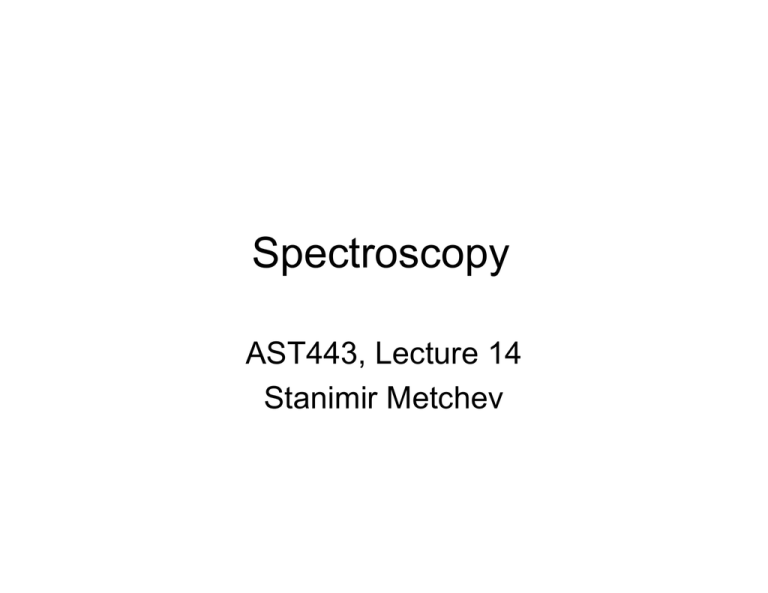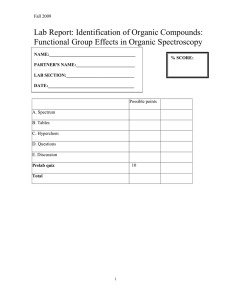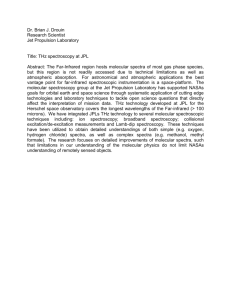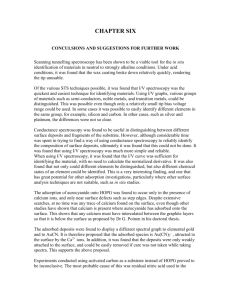Spectroscopy AST443, Lecture 14 Stanimir Metchev
advertisement

Spectroscopy AST443, Lecture 14 Stanimir Metchev Administrative • Homework 2: – problem 5.4 extension: until Mon, Nov 2 • Homework 3: – problems 8.32, 8.41, 10.31, 11.32 of Bradt – due in class Mon, Nov 9 • Reading: – Howell, chapter 6 • Tenagra data: – see bottom of Assignments & Exams section on course website – M11, M52, M37, HD 209458b: all data taken – Hyades: partial observations • Astronomy Town Hall – Wed, 12:30 in ESS450; free pizza – RSVP to Prof. Michael Zingale 2 Outline • Overview – electromagnetic spectra – stellar diagnostics • Diffraction, spectrographs, spectroscopy 3 Examples of Continuum Spectra • optically thin thermal radiation • synchrotron radiation (non-thermal) • blackbody (optically thick) thermal radiation 4 Electronic Transitions • bound-free • free-bound • free-free (bremsstrahlung) 5 Radiative Transfer (again) The optical depth τλ accounts for interaction between photospheric matter and radiation field. 6 Spectral Lines as Atmospheric Diagnostics • chemical content and abundances – mostly H and He, but heavier “metals” (Z > 2) + molecules are important sources of opacity • photospheric temperature – individual line strength – line ratios • photospheric pressure – non-zero line width ⇒ surface gravity g, mass M* • stellar rotation dP GM r # = " 2 = "g# dr r equation of hydrostatic equilibrium – Doppler broadening ! 7 Taking the Stellar Temperature • individual line strengths N n " gn e# $ n kT gn – statistical weight gn = 2n2 for hydrogen • line ratios N n gn #( $ n # $ m ) kT = e N m gm 8 Taking the Stellar Temperature Teff • (Fe II λ5317 / Fe I λ5328) line ratio decreases with decreasing Teff 9 Line Profiles • Natural line width (Lorentzian [a.k.a., Cauchy] profile) – • Heisenberg uncertainty principle: ∆ν =∆E/h Collisional broadening (Lorentzian profile) – – – • ∆tinteraction > ∆temission nearby particles shift energy levels of emitting particle • • • – • ! " collisional = 2 #t coll " pressure % r Stark effect (n = 2, 4) van der Waals force (n = 6) dipole coupling between pairs of same species (n = 3) dependent mostly on ρ, less on T &n ; n = 2,3,4,6 (" % " 0 ) 2 % 1 2 I" = e 2$ 2# $ $ & Gaussian FWHM emitting particles have a Maxwellian distribution of!velocities Rotational Doppler broadening (Gaussian profile) – • #E i + #E f 1 1 " natural = = + h /2$ #t i #t f Thermal Doppler broadening (Gaussian profile) – # /2$ 2 (" % " 0 ) + # 2 /4 # & Lorentzian FWHM collisions interrupt photon emission process ∆tcoll < ∆temission ~ 10–9 s dependent on T, ρ Pressure broadening (~ Lorentzian profile) – – • I" = I0 radiation emitted from a spatially unresolved rotating body Composite line profile: Lorentzian + Gaussian = Voigt profile ! kT mc 2 "rotational = 2# 0 u /c "thermal = # 0 10 ! Example: Surface Gravity Effects at Spectral Type A0 (figure: D. Gray) 11 Line Profiles: Equivalent Width (EW) λ1 "2 EW = $ (F $ "1 ", cont "2 "1 λ2 # F", line )d" F", cont d" 12 Universal Curve of Growth • the ratio of W to Doppler line width Δλ depends upon the product of N and a line’s oscillator strength f in the same way for every spectral line (e.g. Unsöld 1955). 1 re a qu s flat t v # 2kT o o W " # r "# = # = log $ 0 % c c m W" N W " ln N r ' &! ( a e lin 1 W "N ! ! 1 0 m: absorber particle mass 1 ! 2 3 ! 4 log (Nf ) 13 Spectroscopic Binary (a) • double-lined (SB2) – spectra of both stars visible (d) (a) (b) (b) (c) (c) (d) (d) • single-lined (SB1) – only spectrum of brighter star visible 14 Example: SB1 15 Example: SB2 16 Outline • Overview – electromagnetic spectra – stellar diagnostics • Diffraction, spectrographs, spectroscopy 17 Diffraction • multiple orders order overlap 18 Spectrographs • Ebert Spectrograph – flat grating – combining collimator and focuser allows compact design 19 Spectrographs • Wadsworth Spectrograph – curved grating allows compact design 20 HST/STIS Spectrograph 21 Blazing Angle: Efficient m>0 Order Dispersion 22 Echelle Spectrographs: High Dispersion • need to cross-disperse to avoid order overlap 23 Echelle Spectrographs: High Dispersion • high blaze angle 24 Example: A Long-Slit Spectrum • a continuum (telluric) calibrator (a white dwarf) 25 Example: a Long-Slit Spectrum • a galaxy 26 Example: an Echelle Spectrum • RU Lupi • 1100–1700 Å 27 Example: an Echelle Spectrum • Sun • 4000–7000 Å 28 Multi-Object Spectroscopy • use multiple slits • one per science target 29 Multi-Object Spectroscopy • use multiple slits • one per science target 30 Multi-Object Spectroscopy • extracted spectrum of an example target 31 Integral Field Spectroscopy 32 High Contrast Instrumentation: Lenslet IFS – How it works 1. Focal Plane Image 2. Image on Lenslets 3. Pupil images 4. Pupil images dispersed λ 5. Extracted Data Cube y x (credit: UCLA IR lab) λ 33 Dispersing Lenslet Spots (credit: UCLA IR lab) 34 Dispersing Lenslet Spots (credit: UCLA IR lab) 35 OSIRIS (OH-Suppressing InfraRed Imaging Spectograph) Integral Field Spectrograph Spectra over a contiguous rectangular field. Spatial resolution at the Keck Diffraction Limit (< 0.050”) Spectral resolution (λ/Δλ) ~ 3800 Full z, J, H, or K spectra in single exposure (16x64 lenslets) Integrated Data Reduction Pipeline Low Wavefront Error (< 25 nm) y λ UCLA IR Lab x (credit: UCLA IR lab) 36 Keck/OSIRIS Spectra of GQ Lup B GQ Lup B 0.73” 0.73” L5 J-band L0, 2 Gyr L2 GQ Lup B • integral field spectrograph behind Keck AO (PI: J. Larkin, UCLA) GQ Lup B M9 M6 • commissioning OSIRIS data (Aug 2005) J (McElwain, Metchev et al., 2007) L0, 10 Myr H 37 Slitless Spectroscopy • spectra of reentry of ESA’s ATV-1 “Jules Verne” 38 Spectroscopic Calibration • wavelength (dispersion solution) • atmospheric (telluric) + instrumental transmission • spectrophotometry 39 Wavelength Calibration • He, Ar, Ne standard arc lamps • each line has a known wavelength • solve for λ/pix scale “dispersion” • Ne: 6000–7500 A 40 Transmission, Spectrophotometric Calibration • stars with known spectral shapes, featureless continua after calibration – B, A stars – white dwarfs • stars with well known Fλ (spectral flux distributions) – at each λ measure count rate [counts s–1 Å–1] – get λ-dependent conversion factor [erg cm–2 count–1] – need photometric conditions before calibration 41






